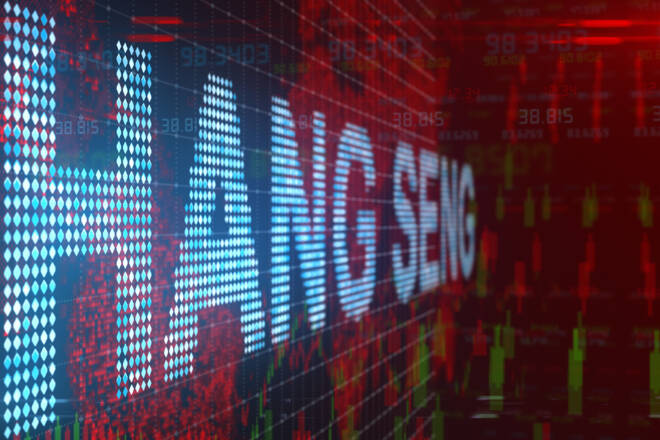Advertisement
Advertisement
Hang Seng Index Drops as Trump Tariff Flip-Flop Shakes Investor Confidence
By:
Key Points:
- The Hang Seng Index fell 1.21% as tech stocks dropped amid confusing US tariff signals and investor caution.
- Beijing’s stimulus efforts limited losses in mainland China stocks despite broader global trade uncertainty.
- Nikkei 225 rose 0.93%, supported by hopes of softer US tariffs and a weaker yen improving Japanese exports.
Wall Street Rallies as Trump Tariff Reversals Jolt Markets
Wall Street surged as hopes of a US-China trade thaw reignited risk appetite, though whiplash from Washington’s shifting stance kept markets on edge. The Nasdaq Composite Index soared 2.50% on Wednesday, April 23, while the Dow and the S&P 500 posted solid gains of 1.07% and 1.67%, respectively.
Expectations that Washington may soften its tariff stance on China fueled demand for risk assets. However, US markets pulled back from session highs on reports of President Trump flip-flopping on China tariffs.
On April 23, the White House downplayed the likelihood of immediate tariff cuts. CN Wire reported:
“White House would look at lowering tariffs on Chinese imports pending talks with Beijing. Any steps would be in conjunction with China talks, not unilateral.”
This marked the second policy pivot in 24 hours, underscoring the ongoing uncertainty surrounding US trade strategy.
US economic data, which included a sharper-than-expected fall in the S&P Global Services PMI, failed to distract investors from trade developments.
Hang Seng Retreats Amid Mixed Tariff Signals
Asian markets tracked a pullback in US Futures. The Hang Seng Index fell 1.21% on Thursday morning as the latest trade developments weighed on investor sentiment. Tech stocks faltered, with the Hang Seng Tech Index sliding 2.04%.
- Tech Stocks: Alibaba (09988.HK) and Tencent Holdings (00700.HK) fell 2.41% and 1.05%, respectively.
- EV makers had a mixed morning session: NIO Inc. (09866.HK) advanced 2.72%, while BYD Co. Ltd. (01211.HK) and Li Auto Inc. (02015.HK) dropped 0.92% and 2.91%, respectively.
David Ingles, Chief Markets Editor at Bloomberg TV Asia Pacific, remarked on tariff developments, stating:
“Honestly it’s been a real struggle to keep up with the US President and his commentary around China and tariffs. Confusing and dizzying.”
Mainland China’s markets gave up early gains as uncertainty lingered. The CSI 300 and the Shanghai Composite Index fell 0.08% and 0.10%, respectively. However, the losses were modest, with Beijing’s stimulus measures mitigating tariff risks.
Nikkei 225 Rallies on Softer US Tariff Stance
Japan’s Nikkei 225 advanced 0.93% on Thursday morning. Hopes of a softer US stance on tariffs and a trade deal with Japan drove demand for Japanese stocks. The USD/JPY pair rallied 1.28% overnight to close at 143.392, adding further support. A weaker Yen may boost the competitiveness of Japanese goods and improve corporate earnings.
Key gainers included Nissan Motor Corp. (7201), up 2.84%, while tech giant Softbank Group Corp. (9984) jumped 3.76%.
ASX 200 Tracks Wall Street Higher
Australia’s ASX 200 gained 0.63% in morning trade. Banking and mining offset losses across gold and oil shares.
- BHP Group Ltd. (BHP) and Rio Tinto Ltd. (RIO) rose 1.01% and 0.94%, respectively, mirroring iron ore’s overnight price gains.
- ANZ (ANZ) and Westpac Banking Corp. (WBC) posted gains of 1.34% and 1.37%, respectively. 10-year US Treasury yields trended lower, boosting demand for high-yielding Aussie bank stocks.
Outlook: Trade, Stimulus, and Central Bank Signals
Easing trade tensions may offer short-term market relief. However, volatility may persist as investors monitor developments in US-China trade negotiations. Meanwhile, stimulus signals from Beijing and guidance from major central banks will also influence risk sentiment.
An extended US-China trade war would likely impact the global supply chain, potentially driving prices higher. Rising prices and weakening global growth could support more dovish central bank rhetoric, potentially supporting risk assets.
In this volatile environment, investors may benefit from strategies aligned with evolving tariff-related, monetary, and geopolitical risks. For further insights, see our latest market coverage.
About the Author
Bob Masonauthor
With over 28 years of experience in the financial industry, Bob has worked with various global rating agencies and multinational banks. Currently he is covering currencies, commodities, alternative asset classes and global equities, focusing mostly on European and Asian markets.
Did you find this article useful?
Latest news and analysis
Advertisement
